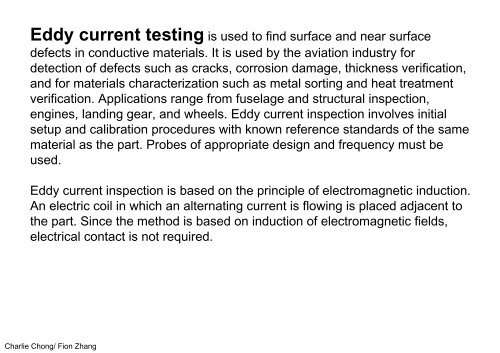Electromagnetic Testing Eddy Current in Brief
You also want an ePaper? Increase the reach of your titles
YUMPU automatically turns print PDFs into web optimized ePapers that Google loves.
<strong>Eddy</strong> current test<strong>in</strong>g is used to f<strong>in</strong>d surface and near surface<br />
defects <strong>in</strong> conductive materials. It is used by the aviation <strong>in</strong>dustry for<br />
detection of defects such as cracks, corrosion damage, thickness verification,<br />
and for materials characterization such as metal sort<strong>in</strong>g and heat treatment<br />
verification. Applications range from fuselage and structural <strong>in</strong>spection,<br />
eng<strong>in</strong>es, land<strong>in</strong>g gear, and wheels. <strong>Eddy</strong> current <strong>in</strong>spection <strong>in</strong>volves <strong>in</strong>itial<br />
setup and calibration procedures with known reference standards of the same<br />
material as the part. Probes of appropriate design and frequency must be<br />
used.<br />
<strong>Eddy</strong> current <strong>in</strong>spection is based on the pr<strong>in</strong>ciple of electromagnetic <strong>in</strong>duction.<br />
An electric coil <strong>in</strong> which an alternat<strong>in</strong>g current is flow<strong>in</strong>g is placed adjacent to<br />
the part. S<strong>in</strong>ce the method is based on <strong>in</strong>duction of electromagnetic fields,<br />
electrical contact is not required.<br />
Charlie Chong/ Fion Zhang


















